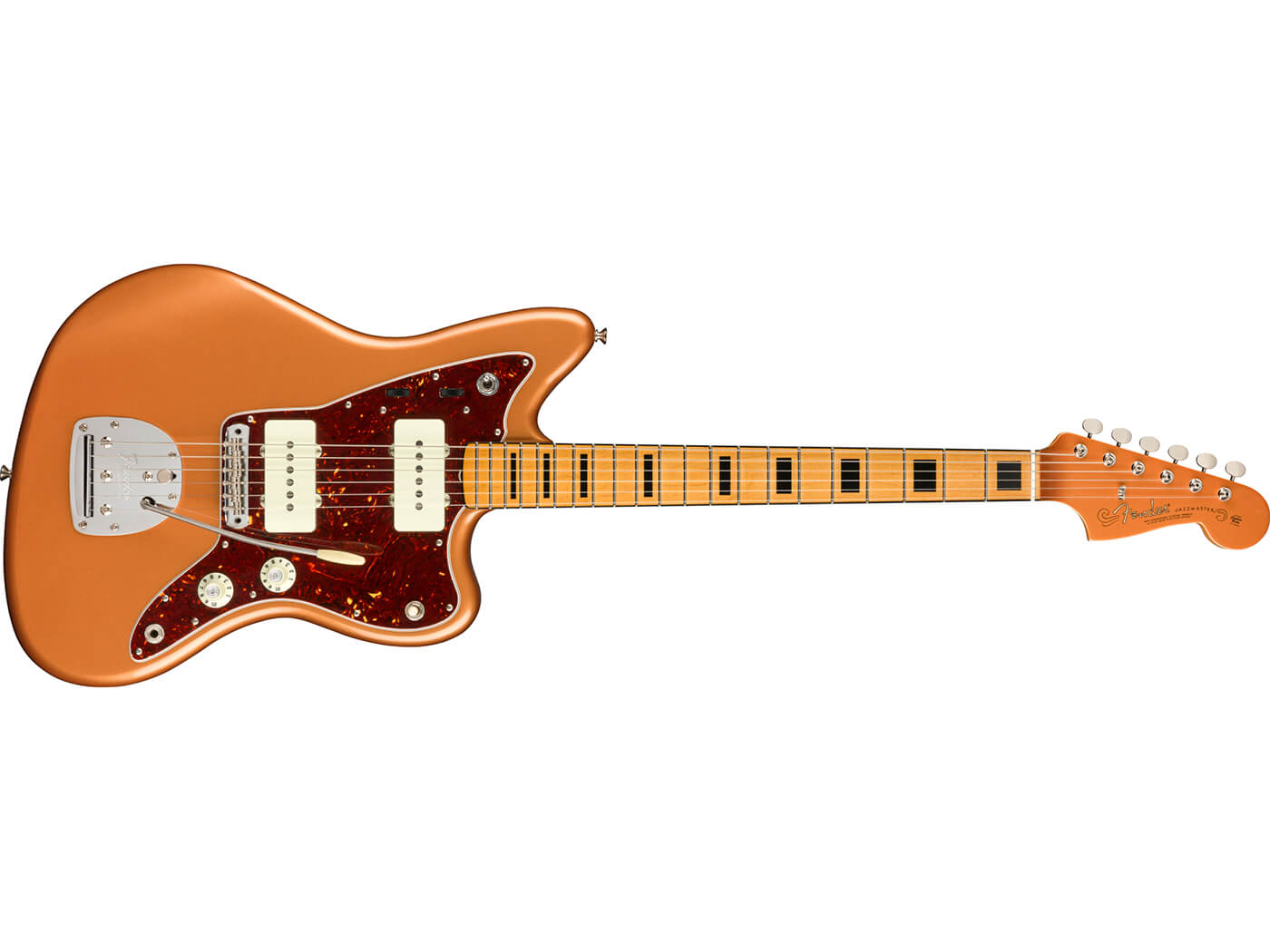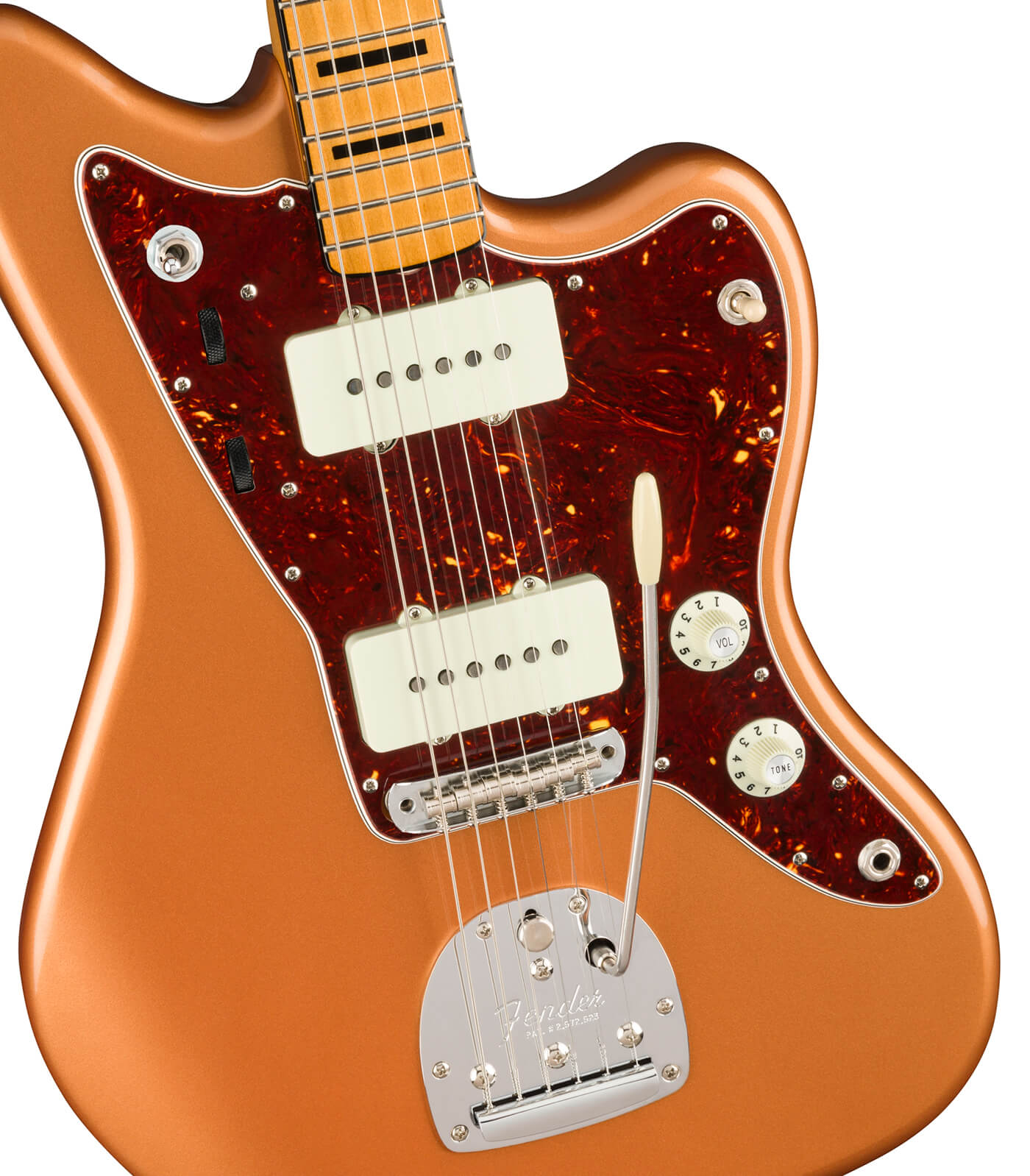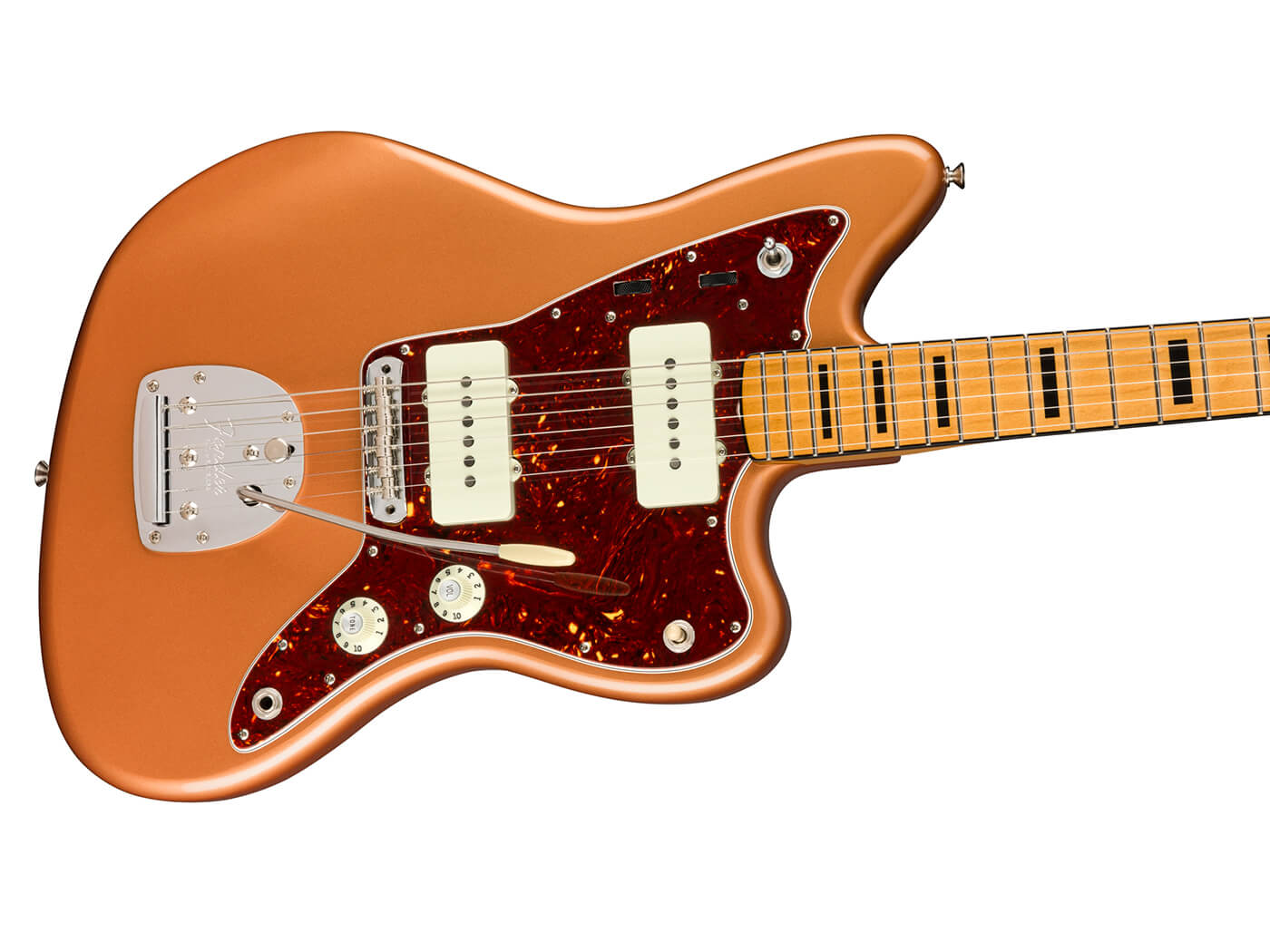“The Jazzmaster is kinda like the underdog, but it’s a secret weapon”: Troy Van Leeuwen on his brand new signature guitar and the future of Queens Of The Stone Age
Troy Van Leeuwen is the shadowy sonic architect who introduced Fender offsets and single-coil pickups to one of the world’s biggest rock bands. The Queens Of The Stone Age guitarist tells us about his new signature Jazzmaster, living the dream with Iggy Pop and the possibility of a new Queens album.

All images: Fender
Either keep moving or die. It’s a maxim that all great bands know to be true, and it’s been quite a journey to date for Queens Of The Stone Age, inarguably one of the biggest rock acts on the planet. With seven stellar records of sonically distinct, bludgeoning desert rock under their belt, all the while the Queens have innovated. Key to that tonal evolution are two guitars: the Fender Jazzmaster and Jaguar, in the hands of Troy Van Leeuwen.
Having initially been parachuted into the band days before taking a 30-song set on the road to promote 2002’s double-Platinum Songs For The Deaf, Van Leeuwen quickly became integral. It was his decision on 2007’s ruthlessly taut Era Vulgaris to bring offset single-coil guitars into a mix that had been dominated by the raw power of humbuckers.
“Over the years, we’ve all changed and grown together and that’s a good segue into the Jazzmaster as a tonal shift that started happening then,” Van Leeuwen explains from the living room of his L.A. home. “The sound of the band has got so wide and sharp that we feel like we can do anything now. It’s been a good ride.”
The primary purpose of today’s transatlantic video call is to discuss the new Fender Troy Van Leeuwen Jazzmaster. His second signature Jazzmaster, it’s a stunning guitar, with a light alder body, Pure Vintage ’65 pickups, maple neck, block inlays and a vivid Copper Age finish. The colour may come as a surprise to those accustomed to seeing Troy clad in black, bringing the moody atmospherics to Queens Of The Stone Age’s live shows, alongside co-conspirator Dean Fertita. His first signature, a striking Oxblood model released in 2014, felt more in keeping with that crepuscular image. But like the rest of his band, Van Leeuwen is aware of the dangers of becoming typecast.

“I’m a guy who’s pigeonholed himself into wearing a suit every night on stage, and it’s always a dark suit,” Van Leeuwen tells us, genial and relaxed in what looks a lot like an Oxblood-coloured polo shirt, a white streak running through his neatly swept ebony hair.
“We call my side the dark side of the stage. Myself and Dean do all the cool, weird stuff, all the verbs and ambience and the stuff you hear on the third listen. There’s the other side of me… I grew up in California, I spent a lot of time in the desert as a kid and this new guitar reminds me of summer.
“At first, I wanted to call the colour Corvet Summer, because that’s a cocktail the Queens like to have backstage. It’s a sunny guitar, a summer guitar, a surf guitar, from a dark brooding goth kid, those are my two sides.”
Fire protection
Van Leeuwen remembers with a knowing smile the moment he was pitched into battle with old friend Josh Homme, coming through an audition on the eve of the five-month Songs For The Deaf tour, which kicked off at LA’s famous Troubadour.
“Luckily, I was a fan, so I knew most of the music already. I’ve known Josh since the 90s. It was like jumping into a fire I was ready for – I had a good fire suit. The first tour, with Dave Grohl on drums, you’ve got these four incredible personalities that are on fire. I just had to look around and say, ‘alright, I’m going to try and keep up with these guys’. I like challenges like that, where you’re thrown into the deep end without knowing how to swim.”
Back to Jazzmasters. There are several other music legends indirectly integral to the story of the pair of arresting signature offsets bearing Van Leeuwen’s name, most notably Chuck Berry, John Bonham, Thurston Moore and Johnny Marr. Born in L.A. in 1970, Van Leeuwen’s earliest exposure to guitar music was when his father would play him Berry’s essential Chess albums on his turntable. It made a lasting impression, inspiring the young Californian to pick up his first guitar – after his first set of drumsticks.
“I played drums first and I was able to mimic whatever I was listening to – Black Sabbath, AC/DC… but when I started getting into Zeppelin I was like, ‘There’s no way I can do what this guy does’. I couldn’t figure out what John Bonham was doing with the kick drum and I got frustrated. My cousin gave me his guitar, a Korean nylon-string acoustic that I got sick of playing after three months. I conned my mom into getting me a Teisco Del Rey, an offset with four single-coil pickups, so it had a lot of combinations of tones. I played it ’til it wouldn’t play anymore.”

Despite that early offset introduction, it took Van Leeuwen a while to fall for the subtly versatile charms of Fender singlecoils, after forming A Perfect Circle in 1999 and joining Homme’s Queens three years later.
“Throughout the 90s and early 2000s, I was a Gibson guy: Les Pauls, 335s, 135s, but throughout the last decade I’ve really been getting into single-coil guitars,” he says. “It started with a Tele and ended up with Jaguars and Jazzmasters. I really wanted to introduce that sound to Queens because there wasn’t a lot of that tone going on, it was all big humbuckers, heavy guitars. Over the years, I’ve introduced it little by little and now it’s a big part of my sound.”
The off set
When it came, that offset awakening centred around two guitars – a refinished, originally Candy Apple, now black 1963 Jaguar and an American Vintage ’62 Jazzmaster Reissue.
“The ’63 Jaguar was my first purchase of a vintage offset,” Van Leeuwen recalls. “I started using it on Era Vulgaris, it’s all over that record. It sort of became this new love, ‘Hey, let’s go out, let’s have fun’. It started becoming my main squeeze. I’m not a vintage guitar nut, I got the ’62 Jazzmaster Reissue in 1998. It’s been beat up, it’s been on the road, it’s been thrown, it’s never been broken and it’s a testament that a new instrument can really sound good. I don’t even think of it as a new instrument anymore. I’m of the school of, play whatever you want. It’s not about what you play, it’s about what you play, that’s my philosophy.”
For decades, offset evangelists have debated the relative merits of Jaguars and Jazzmasters. As an owner of exquisite examples of both, where does Van Leeuwen stand on the subject?
“For me, the Jazzmaster is kinda like the underdog, originally the student model of the Jaguar, but it’s a secret weapon. For Queens, we tune up in C for the old stuff and the Jazzmaster’s longer scale really takes that tuning well. I can leave it for months, pick it up and it’s in tune. For me, the Jazzmaster is like the step child of the Jaguar, and I like that story, I like the underdog.
“The range of tone you can get from a Jazzmaster is vast. You can get the wiriest, single-coil treble that just seers your brain, and then a really creamy solo from the bass circuit. When you put the pickup selector between the two pickups, it’s got this great attack and roundness.
“I always noticed Sonic Youth: ‘Wow, they’re playing behind the bridge, they’ve got pickups behind the bridge’. Elvis Costelllo played one, and when the grunge scene started happening that’s all J Mascis ever played…”

While Sonic Youth’s subversive appropriation of the Jazzmaster sewed a seed in Van Leeuwen’s mind, the influence of another icon linked intrinsically to Fender offsets was equally important in expediting his conversion.
“I remember being on tour in Australia and we played a festival that Modest Mouse were playing, with Johnny Marr guesting. I’m a huge Johnny Marr fan and I don’t remember him ever playing an offset in The Smiths, but he was playing specifically Jazzmasters and Jaguars on that tour. I was lucky enough to sit down with him at a dinner. He was so sweet and cool, and we started talking about offset guitars. I’d just got the ’62 Jazzmaster and I play hard, so the strings kept popping off the bridge. He was the guy that told me about putting Mustang bridges on those guitars, and I stole that from him.”
You’ll find a Mustang bridge on the new Troy Van Leeuwen signature model, and aside from the radically different colour, keen observers will have spotted the other change from the Oxblood incarnation, a switch from rosewood to maple on the fingerboard.
“It doesn’t look anything like my other signature,” says Van Leeuwen. “Aesthetically, it’s so different. It takes it away from a mid-60s to almost a funky 70s look. There were some Jaguars that had that look, maple with the block inlays, but I don’t recall ever seeing a Jazzmaster, so it was partly about making something that looks unique. The maple definitely has an attack that’s a little more present, where the rosewood is a little warmer. It took me a minute to get my head around that, but I was like, ‘you know what, it’s supposed to be different’, and it’s another part of my aesthetic style.”
Pedal power
The pickups from the original signature model have been maintained and Van Leeuwen is quick to emphasise just how well those Pure Vintage single coils take pedals. At this point, we’d love nothing more than to settle in for a comprehensive discussion of his QOTSA pedalboard(s), but mindful that it would fill the rest of the day and Van Leeuwen has a packed schedule of interviews ahead of him, we keep it brief. Lately, he’s been enjoying the Reverberation Machine and Echo Dream 2 from New York’s Death By Audio, as well as a pair of handbuilt stompboxes he designed with Dutch company Dr. No – the Raven filter and boost, and the Octavia, both of which appear on 2017’s Villains. His lockdown amp of choice has been the Echopark Vibramatic 23, made by boutique builder Gabriel Currie, which he took on Iggy Pop’s Post Pop Depression tour in 2016.
“The new guitar is great for pedals,” says Van Leeuwen. “If you put it through just about any pedal, it’s a great colour shift, but you still have the attack. Those ’65 pickups epitomise guitars of that era. They’re not high-output, they’re right in the sweet spot, so they’re good for pedals. I’m a pedal guy and I need stuff you can manipulate.
“Gain structures is something we mess around with in Queens. We use everything from treble boosters to filtering pedals… there’s rarely distortion. There’s bits of fuzz, but there’s just different gain stages from clean to super solo… really loud.”
Talking of getting really loud, that tour with Iggy, culminating in a gig at London’s Royal Albert Hall, must have been a life-affirming experience for Van Leeuwen, Homme and Fertita.

“There were moments on that tour when I thought to myself, ‘How do you beat this?’. You’re on stage with Iggy, going, ‘This is like a dream… a real good dream’. After being on tour for 25 years, the three of us probably had the best gig of our life at the Royal Albert Hall. Working with Iggy was everything you’d ever want and more out of that idea.
“He’s so gracious and out of all of my heroes – a lot of them are gone – you’d think he’d be the one who didn’t make it. He still bleeds every night, he’s 73, and to watch him give everything he has every night is an inspiration. If I can at least try to model my career after what he’s done, I’ll be doing something right.”
Not being able to go out on stage every night has been tough for the normally prolific and ever-gregarious Van Leeuwen, though. While he’s close to finishing an album with Gone Is Gone, the supergroup featuring members of Mastodon and At The Drive-In, he’s not a fan of recording remotely and misses his Queens bandmates. Outside, the Los Angeles sky has been a dystopian murky gold for weeks, the terrifying fires encircling the city meaning going outside has become a perilous experience. And, with coronavirus cases spiraling and America dangerously polarised ahead of a pivotal election, Van Leeuwen admits he’s been having to digest the daily news “in small doses”. It’s been three years since Villains and although they’re booked in to headline Reading & Leeds festival next summer, Homme has already talked about scaling back the band’s touring commitments. Is a new album in 2021 still a possibility? Van Leeuwen is hopeful.
“We’re really missing each other right now and looking for the perfect time to get in a room and start doing stuff,” he concludes. “All the stuff that’s been happening in the world, there’s a lot going on. There’s no shortage of wanting to do it, we all want to do it, it’s just about timing.”
For more on the Troy Van Leeuwen Jazzmaster, visit fender.com.
